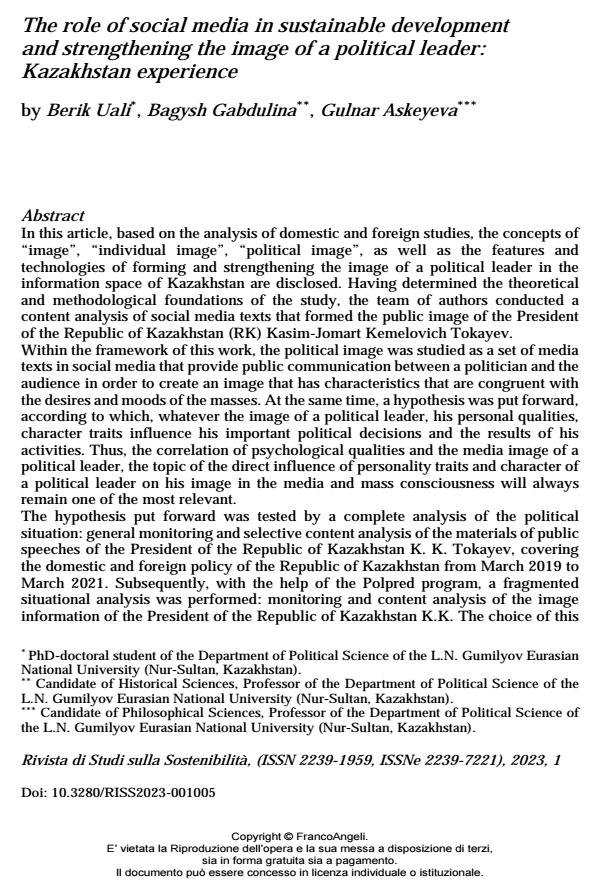The role of social media in sustainable development and strengthening the image of a political leader: Kazakhstan experience
Titolo Rivista RIVISTA DI STUDI SULLA SOSTENIBILITA'
Autori/Curatori Berik Uali, Bagysh Gabdulina, Gulnar Askeyeva
Anno di pubblicazione 2023 Fascicolo 2023/1
Lingua Inglese Numero pagine 18 P. 91-108 Dimensione file 123 KB
DOI 10.3280/RISS2023-001005
Il DOI è il codice a barre della proprietà intellettuale: per saperne di più
clicca qui
Qui sotto puoi vedere in anteprima la prima pagina di questo articolo.
Se questo articolo ti interessa, lo puoi acquistare (e scaricare in formato pdf) seguendo le facili indicazioni per acquistare il download credit. Acquista Download Credits per scaricare questo Articolo in formato PDF

FrancoAngeli è membro della Publishers International Linking Association, Inc (PILA)associazione indipendente e non profit per facilitare (attraverso i servizi tecnologici implementati da CrossRef.org) l’accesso degli studiosi ai contenuti digitali nelle pubblicazioni professionali e scientifiche
In this article, based on the analysis of domestic and foreign studies, the concepts of “image”, “individual image”, “political image”, as well as the features and tech-nologies of forming and strengthening the image of a political leader in the infor-mation space of Kazakhstan are disclosed. Having determined the theoretical and methodological foundations of the study, the team of authors conducted a con-tent analysis of social media texts that formed the public image of the President of the Republic of Kazakhstan (RK) Kasim-Jomart Kemelovich Tokayev. Within the framework of this work, the political image was studied as a set of me-dia texts in social media that provide public communication between a politician and the audience in order to create an image that has characteristics that are con-gruent with the desires and moods of the masses. At the same time, a hypothesis was put forward, according to which, whatever the image of a political leader, his personal qualities, character traits influence his important political decisions and the results of his activities. Thus, the correlation of psychological qualities and the media image of a political leader, the topic of the direct influence of personality traits and character of a political leader on his image in the media and mass con-sciousness will always remain one of the most relevant. The hypothesis put forward was tested by a complete analysis of the political situation: general monitoring and selective content analysis of the materials of public speeches of the President of the Republic of Kazakhstan K. K. Tokayev, covering the domestic and foreign policy of the Republic of Kazakhstan from March 2019 to March 2021. Subsequently, with the help of the Polpred program, a fragmented situational analysis was performed: monitoring and content analysis of the image information of the President of the Republic of Kazakhstan K.K. The choice of this time period was due to the fact that the month of January 2021 in Kazakhstan was politically saturated, i.e., elections were held to the lower house of the Parliament (Mazhilis and Maslikhats), there was a change in the Government of the Republic of Kazakhstan. The method of content analysis of social media texts, which was used in the work, helped to identify the role of modern media in managing the image of a political leader in conditions of social tension, as well as the specifics of working with them in the context of solving this problem. Based on the results of the study of media texts, a model for managing the image of a political leader was developed, consisting of the following elements: factors affecting the image of a political leader; effective methods, technologies and tools for managing the image of a political leader; communication aspect in the use of selected methods, technologies and tools for optimizing public capital. In conclusion, conclusions are formulated about possible mechanisms for strengthening the image of the political leader of the Republic of Kazakhstan in the mass consciousness of Kazakhstanis.
Parole chiave:sustainable development, social media, media text, political image, political leader.
- Cyber warfare: a study of Zelenskyy’s social media political performance strategies and effects Liqiang Wang, Ruonan Wang, in Frontiers in Psychology 1478639/2024
DOI: 10.3389/fpsyg.2024.1478639 - Discourse analysis of Joko Widodo's last state of the nation address 2024 YENIS CONTESA, Surwandono, in Jurnal Studi Komunikasi (Indonesian Journal of Communications Studies) /2024 pp.734
DOI: 10.25139/jsk.v8i3.9042
Berik Uali, Bagysh Gabdulina, Gulnar Askeyeva, The role of social media in sustainable development and strengthening the image of a political leader: Kazakhstan experience in "RIVISTA DI STUDI SULLA SOSTENIBILITA'" 1/2023, pp 91-108, DOI: 10.3280/RISS2023-001005